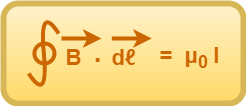Ampere’s Circuital Law-
Ampere’s Circuital law provides us a shortcut method for finding the magnetic field due to infinitely long symmetrical bodies like infinitely long straight wire, infinitely long solenoid, infinite sheet etc.
|
Ampere’s Circuital law states that- The line integral of the magnetic field over any closed loop is equal to μ0 times the net current passing through the area enclosed by this closed loop. |
Mathematically,

The integral on the left hand side is called the magnetic induction.
|
Ampere’s Circuital law can also be stated as- The magnetic circulation around a closed loop is μ0 times the net current enclosed by the loop. |
The closed loop on which the law is applied is called as amperian loop.
Selection of Amperian Loop-
The selection of the amperian loop is critical for easy application of the law. The general rules for selecting the amperian loop are-
Rule-01:
The loop should include the current carrying element whose magnetic field is to be calculated.
Rule-02:
The point or points at which the magnetic field is to be calculated must lie on the loop.
Rule-03:
The loop should have enough symmetry so that the integral on LHS of the law can be easily calculated.
Rule-04:
The magnetic field should be constant over the whole loop or should be easy to calculate on different portions of the loop.
Rule-05:
Estimate the direction of magnetic field around the current carrying conductor before applying the law.
Sign Convention-
While applying the ampere’s circuital law, the following right hand convention is to be used-
- current into the plane of paper is taken negative
- current out of the plane of paper is taken positive
- circulation in anticlockwise direction is taken positive
- circulation in clockwise direction is taken negative.
Important Notes-
Note-01:
If B is everywhere tangent to the integration path and has the same magnitude B at every point on the path, then its line integral is equal to B multiplied by the circumference of the path.
Note-02:
- In the line integral ∮B.dℓ, B is always the total magnetic field at each point on the path.
- In general, this magnetic field is caused partly by currents enclosed by the path and partly by currents outside.
- Even when no current is enclosed by the loop, the magnetic field at points on the loop need not be zero. In that case, however ∮B.dℓ is always zero.
MCQs Quiz-
MCQs Quiz on Ampere’s Circuital Law
Worksheet-
Worksheet on Ampere’s Circuital Law
Next Article-
Magnetic Field Due To Long Thin Straight Wire
Get more notes & other study material of the Chapter Moving Charges & Magnetism.

